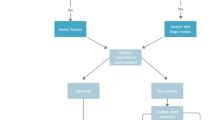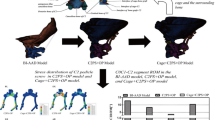Abstract
Background
The treatment of Chiari malformations generally consists of posterior fossa decompression. C1 laminectomy is required in selected cases. However, cases of iatrogenic anterior arch fractures at C1 without high-energy trauma have been reported. Developing theoretical models of atlas C1 bones that have undergone a laminectomy can help researchers identify the regions where fractures may occur as a result of sudden loads.
Methods
In this study, we created a detailed three-dimensional solid finite element model of the human atlas bone (C1) using geometric data. The loadings of the laminectomy dimension were evaluated on the basis of three groups. Group I comprised atlas bones that had not undergone a laminectomy. For Group II, the lateral border of the laminectomy was determined as the projection of the lateral mass medial border on the lamina. For Group III, the bilateral sulcus arteriosus was determined as the border for the lateral border of the laminectomy. The analysis results, which are in good agreement with those of previous reports, showed high concentrations of localized stress in the anterior and posterior arches of the atlas bone.
Results
The analysis results showed that the stress increased in the laminectomy models. The maximum stress observed was consistent with the clinical observations of fracture sites in previous studies.
Conclusion
In the treatment of patients with Chiari malformations, C1 laminectomy is often required. The width of this laminectomy can lead to iatrogenic anterior arch fractures. This is the first study to evaluate C1 laminectomy width using finite element modeling.




Similar content being viewed by others
Data availability statement
The original contributions presented in the study are included in the article, further inquiries can be directed to the corresponding author.
Abbreviations
- CMT1:
-
Chiari malformation type 1
- CSF:
-
Cerebrospinal fluid
References
Hu, Y., Liu, J., Chen, H., Jiang, S., Li, Q., Fang, Y., et al. (2015). A minimally invasive technique for decompression of Chiari malformation type I (DECMI study): study protocol for a randomised controlled trial. British Medical Journal Open, 5(4), e007869.
Goncalves, D., Lourenço, L., Guardiano, M., Castro-Correia, C., Sampaio, M., & Leão, M. (2019). Chiari Malformation Type I in a patient with a novel NKX2–1 mutation. Journal of Pediatric Neurosciences, 14(3), 169.
Levine, A. M. (1991). Atlas fractures. Journal of Bone Joint Surgery America, 73, 630–691.
Jefferson, G. (1927). Remarks on fractures of the first cervical vertebra. British Medical Journal, 2(3473), 153.
Panjabi, M. M., Oda, T., Crisco, J. J., 3rd., Oxland, T. R., Katz, L., & Nolte, L.-P. (1991). Experimental study of atlas injuries .I. Biomechanical analysis of their mechanisms and fracture patterns. Spine, 16(10 Suppl), S460–S465.
Baghdassarian, A., Piatt, J. H., Jr., & Giordano, K. (2014). Fracture of the anterior arch of atlas after minor trauma of the immature spine postlaminectomy. Pediatric emergency care, 30(5), 340–342.
O’Shaughnessy, B. A., Salehi, S. A., Ali, S., & Liu, J. C. (2004). Anterior atlas fracture following suboccipital decompression for Chiari I malformation: Report of two cases. Journal of Neurosurgery: Spine, 1(1), 137–140.
Shimizu, T., Otsuki, B., Fujibayashi, S., Takemoto, M., Ito, H., Sakamoto, T., et al. (2016). Spontaneous anterior arch fracture of the atlas following C1 laminectomy without fusion: a report of three cases and finite element analysis. Journal of Orthopaedic Science, 21(3), 306–315.
Shimizu, T., Otsuki, B., Fujibayashi, S., Kumamoto, S., Hijikata, Y., Shimizu, Y., et al. (2018). Incidence and risk factors of anterior arch fracture of the atlas following C1 laminectomy without fusion. Spine, 43(10), 667–674.
Teo, E. C., & Ng, H. W. (2001). First cervical vertebra (atlas) fracture mechanism studies using finite element method. Journal of biomechanics, 34(1), 13–21.
Beckner, M. A., Heggeness, M. H., & Doherty, B. J. (1998). A biomechanical study of Jefferson fractures. Spine, 23(17), 1832–1836.
Zhang, Q. H., Teo, E. C., Ng, H. W., & Lee, V. S. (2006). Finite element analysis of moment-rotation relationships for human cervical spine. Journal of biomechanics, 39(1), 189–193.
Puttlitz, C. M., Goel, V. K., Clark, C. R., Traynelis, V. C., Scifert, J. L., & Grosland, N. M. (2000). Biomechanical rationale for the pathology of rheumatoid arthritis in the craniovertebral junction. Spine, 25(13), 1607–1616.
Goel, V. K., & Clausen, J. D. (1998). Prediction of load sharing among spinal components of a C5–C6 motion segment using the finite element approach. Spine, 23(6), 684–691.
Erbulut, D. U., Zafarparandeh, I., Lazoglu, I., & Ozer, A. F. (2014). Application of an asymmetric finite element model of the C2–T1 cervical spine for evaluating the role of soft tissues in stability. Medical engineering physics, 36(7), 915–921.
Hansraj, K. K. (2014). Assessment of stresses in the cervical spine caused by posture and position of the head. Surg Technol Int, 25(25), 277–279.
Eren, B., KaragözGüzey, F., & Adresi, Y. (2015). Chiari Tip 1 Malformasyonunda nüks ve Tedavisi Recurrence in Chiari Type 1 Malformation and Its Treatment. Türk Nöroşir Derg, 2, 272–280.
Greenberg, J. K., Ladner, T. R., Olsen, M. A., Shannon, C. N., Liu, J., Yarbrough, C. K., et al. (2015). Complications and resource use associated with surgery for Chiari malformation type 1 in adults: A population perspective. Neurosurgery, 77(2), 261–268.
Kumar, A., Bhattacharjee, S., & Sahu, B. P. (2014). Importance of C1 laminectomy in foramen magnum decompression surgery: A technical note. Asian Journal of Neurosurgery, 9(4), 235.
Hirano, Y., Sugawara, A., Mizuno, J., Takeda, M., Watanabe, K., & Ogasawara, K. (2011). Spontaneous C1 anterior arch fracture as a postoperative complication of foramen magnum decompression for Chiari malformation type 1. Surgical neurology international, 2, 138.
Takemoto, M., Neo, M., Fujibayashi, S., Sakamoto, T., Ota, M., Otsuki, B., et al. (2016). Clinical and radiographic outcomes of C1 laminectomy without fusion in patients with cervical myelopathy that is associated with a retro-odontoid pseudotumor. Clinical spine surgery, 29(10), E514–E521.
Aghakhani, N., Parker, F., David, P., Morar, S., Lacroix, C., Benoudiba, F., et al. (2009). Long-term follow-up of Chiari-related syringomyelia in adults: analysis of 157 surgically treated cases. Neurosurgery, 64(2), 308–315.
Furtado, S. V., Thakar, S., & Hegde, A. S. (2011). Correlation of functional outcome and natural history with clinicoradiological factors in surgically managed pediatric Chiari I malformation. Neurosurgery, 68(2), 319–328.
Gebauer, M., Goetzen, N., Barvencik, F., Beil, F. T., Rupprecht, M., Rueger, J. M., et al. (2008). Biomechanical analysis of atlas fractures: a study on 40 human atlas specimens. Spine, 33(7), 766–770.
Jin, M., Asadoorian, M., Hiller, L. P., & Hughes, T. H. (2014). Hypertrophy of the anterior arch of the atlas associated with congenital nonunion of the posterior arch: A retrospective case-control study. The Spine Journal, 14(7), 1155–1158.
Fagan, M. J., Julian, S., & Mohsen, A. M. (2002). Finite element analysis in spine research. Proceedings of the institution of mechanical engineers, part h: Journal of engineering in medicine, 216(5), 281–298.
Kim, Y. H., Khuyagbaatar, B., & Kim, K. (2018). Recent advances in finite element modeling of the human cervical spine. Journal of Mechanical Science and Technology, 32(1), 1–10.
Kinzel, G. L., Hall, A. S., Jr., & Hillberry, B. M. (1972). Measurement of the total motion between two body segments—I. Analytical development Journal of Biomechanics, 5(1), 93–105.
Funding
The authors declare that no funds, grants, or other support were received during the preparation of this manuscript.
Author information
Authors and Affiliations
Contributions
All authors contributed to the study conception and design. Material preparation, data collection and analysis were performed by AEK, EK, BAT, BB. The first draft of the manuscript was written by AEK, CKY, MUE, ATÇ, and SN contributed to the editing and reviewing of the manuscript during the revision phase. All authors commented on previous versions of the manuscript. All authors read and approved the final manuscript.
Corresponding author
Ethics declarations
Conflict of Interest
The authors have no relevant financial or non-financial interests to disclose.
Ethical Approval
This is an observational study. The Umraniye Training and Research Hospital Ethics Committee has confirmed that no ethical approval is required.
Consent to Participate
This study does not include patient data
Consent to Publish
This study does not include participant images
Additional information
Publisher's Note
Springer Nature remains neutral with regard to jurisdictional claims in published maps and institutional affiliations.
Rights and permissions
Springer Nature or its licensor (e.g. a society or other partner) holds exclusive rights to this article under a publishing agreement with the author(s) or other rightsholder(s); author self-archiving of the accepted manuscript version of this article is solely governed by the terms of such publishing agreement and applicable law.
About this article
Cite this article
Kayalar, A.E., Yaltırık, C.K., Kalyoncu, E. et al. Maximum Safety Limits of Laminectomy of the C1 Vertebra for Chiari Malformation Surgery: A Finite Element Analysis. JOIO 57, 884–890 (2023). https://doi.org/10.1007/s43465-023-00870-1
Received:
Accepted:
Published:
Issue Date:
DOI: https://doi.org/10.1007/s43465-023-00870-1




